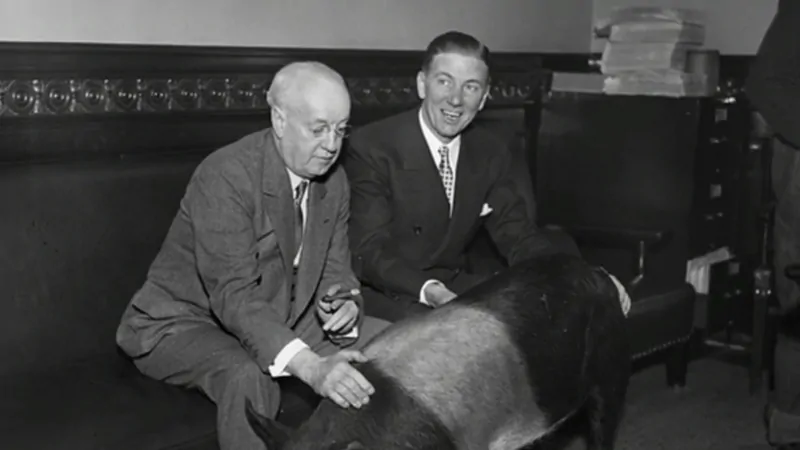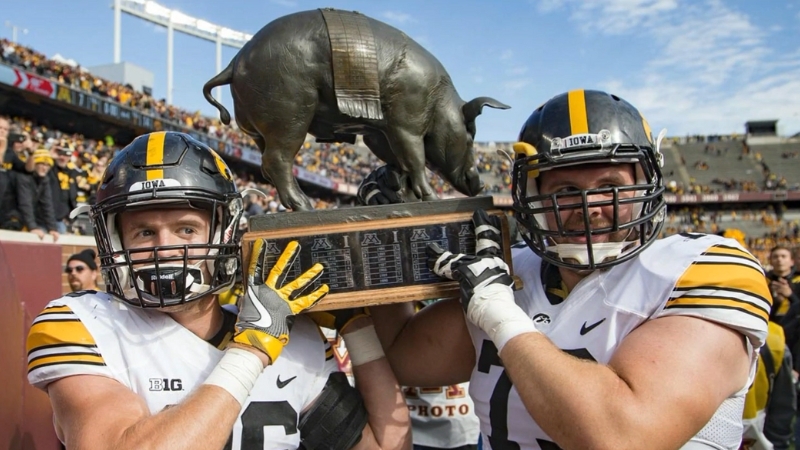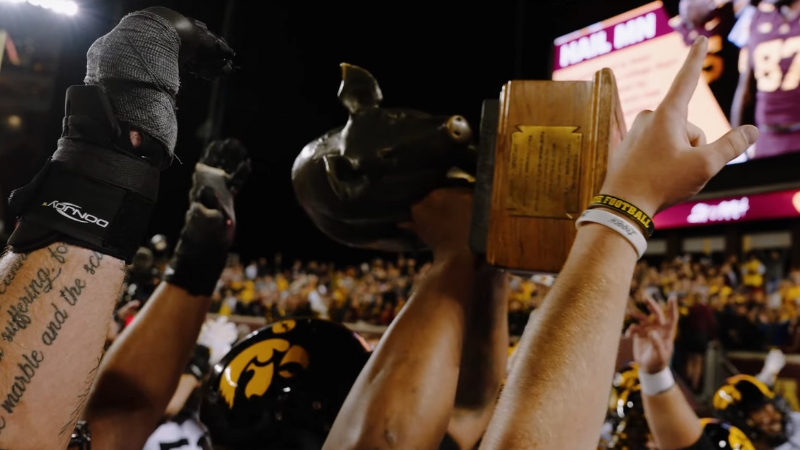In a state where cornfields stretch to the horizon, where farmers rise with the sun, and where black and gold run deep in fall Saturdays, it takes something special to stand out.
So when a pig becomes one of Iowa’s most treasured symbols – not just in sports, but in state pride – you know the story has some weight to it. That pig’s name? Floyd of Rosedale. Yes, it’s a bronze pig. And yes, it might just be the most famous pig in Iowa history.
Floyd of Rosedale isn’t your average football trophy. He’s heavy with history – literally 98 pounds of bronze – and even heavier in meaning.
Born out of a racial controversy, a political wager, and one of college football’s longest-running rivalries, Floyd carries more than school pride between Iowa City and Minneapolis. He carries a legacy.
A Game That Sparked More Than Points

What happened on a chilly November afternoon in 1934 wasn’t just a rough game between Big Ten rivals. It was something deeper.
Players got hurt, tempers flared, and by the time the final whistle blew, the scoreboard didn’t tell the whole story. What stuck with people wasn’t the 48-12 loss – it was what happened to one player and how the crowd responded.
That game set off a chain of events that would stretch far beyond the football field and straight into Iowa history.
The 1934 Clash in Iowa City
You have to go back to November 2, 1934. The Iowa Hawkeyes were hosting the Minnesota Golden Gophers in what was expected to be just another hard-fought football game. But it turned ugly fast.
Iowa’s standout halfback, Ozzie Simmons, was knocked unconscious not once, not twice, but three separate times. Each time he went down, fans in the stands grew more outraged.
Simmons, one of the only Black players in the Big Ten at the time, wasn’t new to rough play. But this was different. It felt deliberate. Later, he said, “They were piling on… knees high… it was pretty obvious.”
Minnesota rolled to a 48-12 win, but few were talking about the score afterward. Iowa fans, coaches, and reporters couldn’t shake the feeling that Simmons had been targeted.
Race and Football in the 1930s
The fallout hit hard. Remember, this was the 1930s. Jim Crow laws were still in full effect in many parts of the country. Black athletes like Simmons weren’t just breaking records – they were breaking barriers, often while being attacked on and off the field.
So when Iowa was set to travel to Minneapolis for the 1935 rematch, tensions were already boiling. Fans wrote angry letters. Rumors swirled about retaliation. It wasn’t just a football game anymore. It felt like a powder keg.
The Governors Step In

With tensions rising and fans on edge before the 1935 rematch, the usual pregame hype took on a sharper edge. Letters were flying, rumors were swirling, and you could feel the unease creeping into both states.
It wasn’t just about football anymore. That’s when Minnesota’s Governor Floyd Olson stepped into the spotlight – not with outrage or blame, but with a bet and a pig.
Floyd B. Olson’s Unlikely Bet
Minnesota Governor Floyd Olson saw trouble coming. Rather than wait for something to explode, he took an unexpected route. He reached out to Iowa Governor Clyde Herring with a challenge that was part Midwest humor, part diplomatic move: let’s make a friendly bet.
The winner gets a prized pig from the loser’s state. He joked in a telegram, “If you seriously think Iowa has any chance to win, I will bet you a Minnesota prize hog.” Herring agreed.
The bet worked. It shifted the tone. Suddenly, reporters were talking about pigs instead of payback.
The Game and the Pig
Minnesota won again, 13-6. And Iowa kept its word. A few days later, a black Hampshire boar from Rosedale Farms in Webster County, Iowa, was loaded into a truck and delivered to the Minnesota Capitol.
The pig was named Floyd, in honor of Governor Olson. His full name: Floyd of Rosedale. He made headlines, posed for photographs, and even received a brief stay on a farm near Rochester, Minnesota.
But by the following summer, Floyd had died of cholera. His legacy, though, was just beginning.
A Bronze Pig Takes the Field
Before long, it was clear that hauling a live hog across state lines every fall wasn’t exactly sustainable. So Minnesota decided to make it official. No more truck beds, no more pens.
What came next was a 98-pound tribute cast in bronze – a trophy that would outlive the players, the coaches, and even the original pig himself. Floyd was about to take on a whole new life.
Creating the Trophy
After the live pig’s short tenure, officials decided the tradition needed a more permanent fixture. Enter Charles Brioschi, a sculptor from St. Paul. He was commissioned to create a bronze replica of Floyd, and what he delivered was part art piece, part statement.
Weighing 98 pounds, standing about 15.5 inches tall and stretching 21 inches long, the new Floyd of Rosedale trophy became the prize for the annual Iowa-Minnesota game starting in 1936. It remains one of the oldest and most recognizable traveling trophies in college football.
Why It Mattered
The move wasn’t just about preserving tradition – it was about progress. The 1934 game had exposed the ugly racial realities of the era.
The trophy turned a flashpoint into something unifying. Simmons himself once said, “It showed that sports can bring people together, even after a tough moment like that.”
The Long Road Between Iowa City and Minneapolis

Every fall, that bronze pig makes the journey up or down I-35, depending on who earned the bragging rights. It’s not just a change of scenery for Floyd – it’s a shift in pride, a moment that echoes through locker rooms, family watch parties, and hometown bars across two states.
The rivalry between Iowa and Minnesota isn’t just about football. It’s about decades of tradition, small-town loyalty, and the unshakable belief that your side deserves to hold the pig one more year.
A Rivalry Like No Other
As of 2024, the Hawkeyes and Gophers have clashed 119 times. Minnesota still holds the overall edge, with 63 wins to Iowa’s 52, plus a couple of ties. But since the early 2000s, Iowa’s had the upper hand.
The trophy has spent more time in Iowa than Minnesota over the past two decades. And every year, no matter the team’s record, fans on both sides circle the game on their calendar.
Because winning Floyd is very personal.
Where Floyd Has Traveled
| Year | Winner | Score | Trophy Location |
| 1935 | Minnesota | 13-6 | Minnesota |
| 2001 | Iowa | 42-28 | Iowa |
| 2023 | Minnesota | 12-10 | Minnesota |
| 2024 | Iowa | 31-14 | Iowa |
In 2005, Iowa won the game but accidentally left Floyd behind in Minnesota. A logistical blunder, sure, but it gave fans a reason to laugh. The pig was safely returned.
Today, when Iowa holds the trophy, Floyd is often displayed at the University of Iowa’s Pentacrest Museums. When Minnesota wins, the pig is shown off at TCF Bank Stadium or trotted out for pep rallies and fairs.
The Man Behind the Moment – Ozzie Simmons
66 DAYS UNTIL IOWA FOOTBALL
#66 – Ozzie Simmons
HB | 1934–1936One of Iowa’s first Black stars, Simmons’ toughness vs. Minnesota led to the creation of the Floyd of Rosedale trophy, still one of college football’s best traditions.#IowaFootballCountdown pic.twitter.com/UxgMEjdZdk
— HAWK_GUYS (@HAWK_GUYS) June 25, 2025
Ozzie Simmons wasn’t just a talented player. He was tough, quiet, and consistently excellent on the field. Born in Fort Worth, Texas, he made his mark at the University of Iowa as a halfback who could cut through defenses like butter.
They called him the “Ebony Eel” for his slick moves. But he had to earn every yard under intense scrutiny. After college, Simmons didn’t go pro. The NFL wasn’t exactly rolling out welcome mats for Black players at the time.
Instead, he went into law and spent his life helping others. He died in 2001 in Chicago, leaving behind a story that still resonates.
Floyd’s Footprint in the 21st Century
Floyd may have been born in the 1930s, but he’s never faded into the background. If anything, the bronze pig has only gotten more famous with age. Every fall, his name lights up sports headlines across the Midwest.
Coaches reference him in press conferences. Fans chant for him in the stands. And when the game clock hits zero, players sprint toward him like he’s royalty. In the 21st century, Floyd isn’t just surviving – he’s thriving.
2023: The Controversy
In 2023, the rivalry was anything but quiet. Minnesota pulled off a narrow 12-10 win, but the game ended with a fair catch signal that wiped out a potential Iowa return touchdown.
Fans were livid. Social media exploded. Sports radio lit up for days. It didn’t just sting – it lit a fire under Iowa.
2024: The Comeback
A year later, the Hawkeyes came to Minneapolis hungry. They walked away with a 31-14 victory and Floyd back in tow. Running back Kaleb Johnson was a wrecking ball, racking up over 200 rushing yards.
Head coach Kirk Ferentz summed it up simply: “Our players know what’s at stake. Floyd is a big part of that.” The win meant more than bragging rights. It felt like setting the record straight.
Floyd Beyond the Field
Floyd might’ve been born on a farm and raised on the gridiron, but his story didn’t stop at the final whistle. Over the years, the bronze pig has rooted himself deep into the everyday rhythm of Iowa and Minnesota life.
From public art to classroom lessons, Floyd has become more than a football trophy – he’s a cultural icon, a teaching tool, and a quiet reminder that even the most unexpected symbols can carry lasting meaning.
A Statue in Fort Dodge
In 2021, Fort Dodge – home of the original Rosedale Farms – unveiled a statue in Floyd’s honor. It’s not just about a pig. It’s about a piece of Iowa history.
Locals visit it, school groups learn about it, and for many, it’s a reminder that even small things can hold deep meaning.
In the Classroom
Floyd’s story has made its way into textbooks and teaching materials. Teachers use it to talk about race, sports, politics, and how communities heal.
For students, it’s a way to connect with history that feels real, not just names and dates in a binder.
In Pop Culture
You can find Floyd of Rosedale on shirts, hoodies, posters, even bobbleheads. He’s become a mascot of sorts – not just for a team, but for a tradition.
You’ll spot him at the Iowa State Fair, alumni tailgates, and college bars. Wherever there’s Hawkeye or Gopher pride, Floyd’s not far.
Why Floyd Still Matters

There are flashier trophies in sports. Bigger rivalries. Louder stadiums. But Floyd endures because he’s rooted in something real. His story wasn’t scripted by marketing teams or sports networks.
It was born from tension, softened by humor, and shaped by history. Long before the state became a leader in the nation’s wind energy revolution, Iowa was already proving it could turn its unique character into lasting traditions.
In a world that moves fast and forgets quickly, Floyd of Rosedale has stuck around. Not just as a trophy, but as a reminder of what can happen when people choose tradition over retaliation, sportsmanship over spite.
So next time you hear about a college football game between Iowa and Minnesota, pay attention. It’s not just a border battle. It’s a story that started with a bruised halfback, a worried governor, and a pig named Floyd. And somehow, almost a century later, it’s still going strong.












